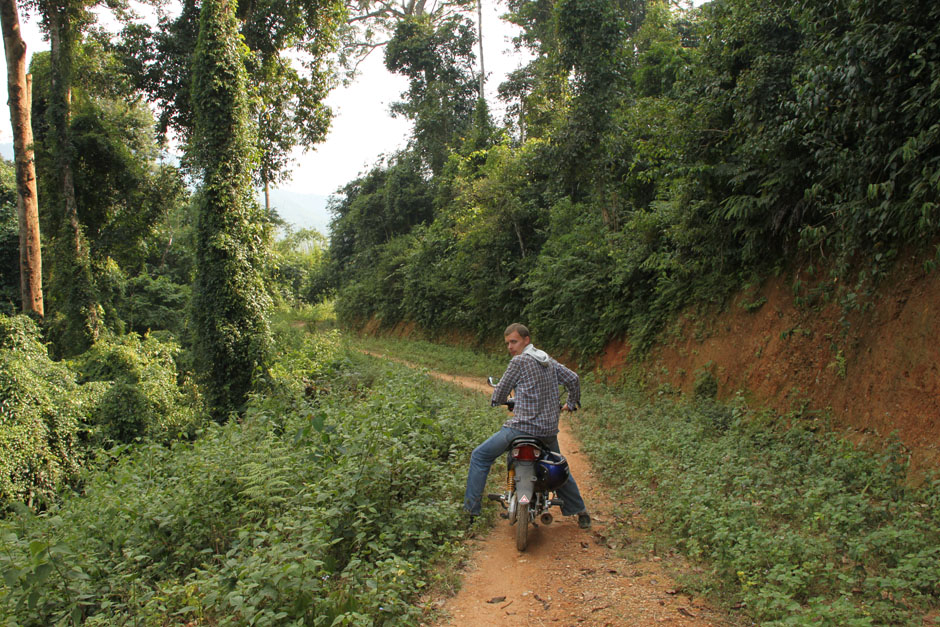

Why today?
Of course, we can say that the very first start was in March of 2011 when I just discovered Phongsaly, in northern Laos — its beautiful countryside with mountains, rivers, and old tea trees. Then on my way back to China I convinced myself to devote all summer to the learning about the process of making tea.
Or maybe later that year, in September when I came back to Phongsaly again and spent the entire month driving around in search of the best tea gardens.
Or maybe the project really began in December when we got financial support and the first requests for new Laos’s tea.
But only today, on February 22, 2012, while walking on a quite spring evening on the streets of Phongsali I did have a realization — our project has just begun in earnest.
Why make our own tea?
After so many years working with tea and tasting different teas, we had developed some basic criteria which define a «good quality tea». The most important one is that it must be organically grown without using any kind of pesticides. Another is that the tea must actually grow on mountainsides, versus flat fields. Also, the whole process, from picking tea leaves to making raw tea should be done by hand by a real person, not a machine. In China, there are lots of well-made delicious sorts of teas that are very expensive. Tempted by a chance to make more money, some tea manufactures create a mix that is 50% tea leaves from different plantations. That is why, for example, it is not easy at all to purchase true Pu-erh made only from leaves of old tea trees.
But the main reason we want to create our own tea is because tea making is a very interesting and enjoyable process. We start from the morning when freshly harvested leaves are brought in, and continue all day, interacting with the tea, following it through the stages of it’s preparation. This is our work of art — the creating of flavors, fragrances and, in case of tea, also moods.
Why in Laos?
There are several reasons to start fine tea production particularly in Laos. The first is its ancient location. The north part of Laos, Phongsaly Province is used to be a part of Sishuban until the beginning of nineteenth century. Since that time, the old tea trees have been here growing wild and in tea gardens. Such pure, undeveloped tea production is difficult to find now in Yunnan, in nearby south of China.
The second reason is the unique environment of Phongsaly Province. People who live in this region mostly belong to a few small ethnic groups. Their traditional way of living is very simple and sometimes even primitive. Most villages do not have electric power. All work is done by hand. Tea has for ages been grown here without any pesticides and harvested only by local people.
The capital of Phongsaly Province is Phongsali. The town has about 6,000 inhabitants and is located at an ideal altitude of approximately 1430 meters (4691 feet) on the slopes of Mount Phu Fa. The climate is perfect for growing tea — cold foggy winter and warm rainy summer. There is no industrial development in the area. The only road to the town is gravel, a curvy serpentine wrapping around the mountain. Difficult access makes this place hard to approach. To get to the nearest airport, in Luang Prabang, you either spend two days in a car driving on that bad road or take a boat down the river, which takes three days. Your choice!

View on Phongsali. A sea of clouds is often surrounded the town in morning times.
What are we going to do here?
Lao people have a very different culture from their Chinese neighbors who live just over the mountains. Traditionally, the harvesting and making tea here is done only in small amounts for home use. During the 1990s, the local government began to support tea farming. New tea gardens were planted but local farmers did not know how to produce a high quality tea for export. Their method was still very primitive and the tea sometimes was not very good.
Therefore, we decided to start our own production in this attractive location, making black and green tea, and Sheng, (made from large tea leaves from the trees). We have purchased the necessary equipment and have invited an experienced tea technologist to work with us.
This website is intended to keep our friends and fans informed about our tea experiment. Here we will post our notes, photos and video materials about how we are moving along with our project. We will be sharing with our readers all our ups and downs, some fun stories and first mistakes which no one can avoid when following a new pathway. And we have local friends who will appear in the pages of this site too.
So, let’s go!
